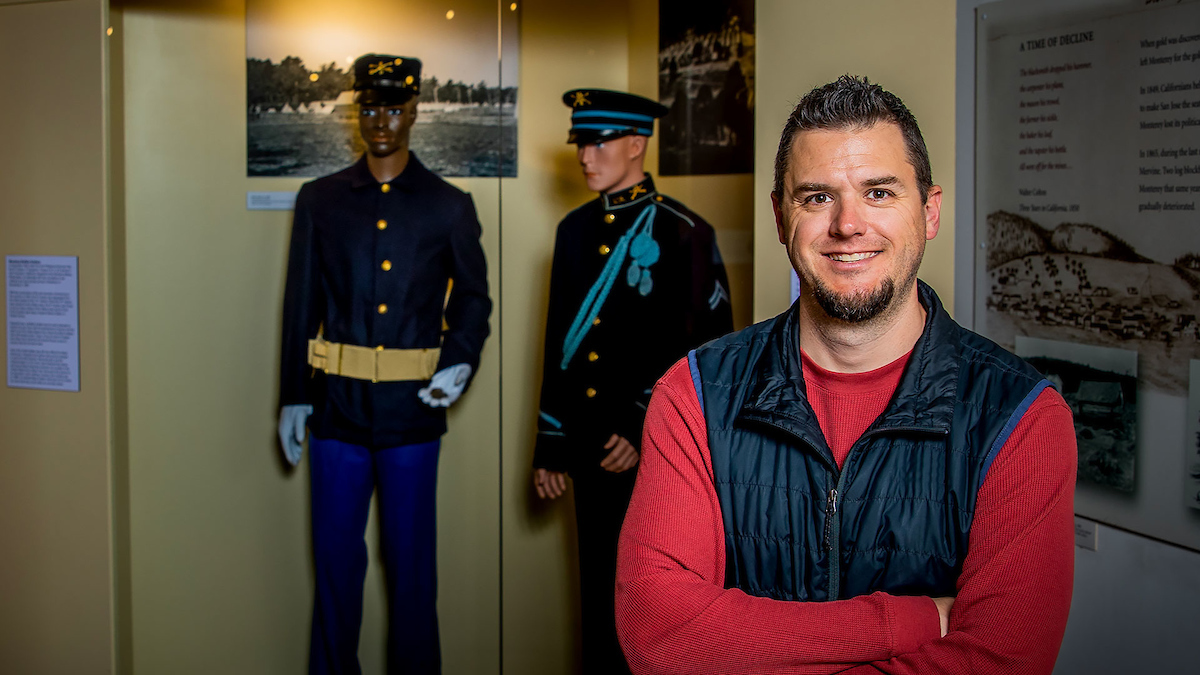CSUMB alum curates Buffalo Soldiers exhibit to open Juneteenth weekend

Jordan Leininger at the Presidio of Monterey Museum | Photo by Brent Dundore-Arias
June 15, 2023
By Walter Ryce
About 120 years ago, the Monterey Peninsula served for two years as the home base for the 9th Cavalry of Black soldiers known as the Buffalo Soldiers.
That history is the subject of an exhibit opening Juneteenth weekend at the Presidio of Monterey Museum in the Lower Presidio Historic Park, curated by CSUMB alumnus Jordan Leininger (Class of 2018).
The exhibit expands on a history that Leininger believes has been overlooked by locals.
The Buffalo Soldier cavalry and infantry regiments fought in the Civil War, the Spanish-American War, and the Plains Wars. They helped the U.S. government’s westward expansion into indigenous lands, and patrolled and maintained National Parks.
Their history and lore have been told in songs, including Bob Marley’s “Buffalo Soldiers,” and films, such as Spike Lee’s “Miracle at St. Anna.” According to the National Museum of African American History and Culture, “Black soldiers used military service as a strategy to obtain equal rights as citizens.”
Buffalo Soldiers regiments were active for nine decades.
“The history behind these men is incredible,” Leininger said. “A lot of people don’t know the Monterey history, the things they overcame before, during, and after the military. Why would [they] want to fight for this country that didn’t care about them?”
He honed that kind of intellectual curiosity at CSUMB.
Leninger majored in social and behavioral studies with a concentration in social history. But he didn’t know what he wanted to do until 2016 when he did his service learning with the City of Monterey’s Museums and Cultural Arts Division.
“I found my calling,” Leininger said.
Months after he graduated, the city’s museums division offered him a job. He later earned a promotion to artifacts specialist, managing and curating the city’s museums, archives and special collections.
The Buffalo Soldiers exhibit shines a light on local military history.
“In late November of 1902, the Buffalo Soldiers cavalry arrived [in Monterey] and were segregated from white troops [and camped] in Pacific Grove’s China Point, where Hopkins Marine Station is today,” Leininger said.
They participated in parades, sports, marksmanship and horseback events that drew many spectators to China Point. When a nearby Chinese fishing village caught fire, the Buffalo Soldiers helped to extinguish the flames. In 1904 they rode to Yosemite National Park and created the first marked National Park trail.
Still, there were complaints about the Black soldiers being given opportunities not normally afforded to Black people.
The exhibit is titled “Extraordinary Valor: The Lost History of the Buffalo Soldiers in Monterey” as Leininger’s homage to those soldiers, and also to acknowledge that their history has been obscured.
It comprises photographs, a map, a print of a newspaper clipping, and two mannequins dressed in the period uniforms of soldiers — one white, one black — with photos of their respective and segregated camps behind them.
“It’s not a large exhibit, but what it represents is larger than what you can see,” he said.
He said that CSUMB taught him skills and showed him perspectives that have helped him in his current role.
“I learned the historical method, how to research, write, and look at sources,” he said. “I also learned how to look at history through different lenses, what different people were going through during [historical events].”
Leininger won’t be able to attend the exhibit’s grand opening, but is expecting special visitors, including the daughter of a Buffalo Soldier who fought in the Spanish American War; as well as a Buffalo Soldier historian and collector whose grandfather was stationed at the Presidio of Monterey and fought alongside Teddy Roosevelt.
The Buffalo Soldiers exhibit, which joins other exhibits of the Presidio’s military lineage dating back to the indigenous period, will be permanent. The grand opening coincides with the country's newest federal holiday, Juneteenth, which remembers the two-and-a-half years it took for slaves in Galveston, Texas, to be officially notified that they had been freed by the 1863 Emancipation Proclamation.
“I hope people will come check it out and appreciate the service these men gave to their country,” Leininger said. “I’m always looking to get as much information as I can. We don’t have much. I would love to continue this research.”
“Extraordinary Valor: The Lost History of the Buffalo Soldiers in Monterey” opens at 10 a.m. Saturday, June 17, with a free public reception 12 - 1 p.m., as one of several local Juneteenth holiday commemorations. Regular museum hours are 10 a.m. to 4 p.m. Saturday and Sunday. The museum is located at Lower Presidio Historic Park, 76th Artillery Street and Corporal Ewing Road, Building 113, Monterey.